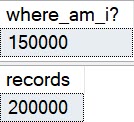No, Not That Bug
There’s a known bug with partitioned tables, but this is different. This one is with rows in the delta store.
Here’s a quick repro:
USE tempdb;
DROP TABLE IF EXISTS dbo.busted;
CREATE TABLE dbo.busted ( id BIGINT, INDEX c CLUSTERED COLUMNSTORE );
INSERT INTO dbo.busted WITH ( TABLOCK )
SELECT TOP ( 50000 )
1
FROM master..spt_values AS t1
CROSS JOIN master..spt_values AS t2
OPTION ( MAXDOP 1 );
-- reports 0, should be 50k
SELECT CAST(OBJECTPROPERTYEX(OBJECT_ID('dbo.busted'), N'Cardinality') AS BIGINT) AS [where_am_i?];
SELECT COUNT_BIG(*) AS records
FROM dbo.busted;
INSERT INTO dbo.busted WITH ( TABLOCK )
SELECT TOP ( 150000 )
1
FROM master..spt_values AS t1
CROSS JOIN master..spt_values AS t2
OPTION ( MAXDOP 1 );
-- reports 150k, should be 200k
SELECT CAST(OBJECTPROPERTYEX(OBJECT_ID('dbo.busted'), N'Cardinality') AS BIGINT) AS [where_am_i?];
SELECT COUNT_BIG(*) AS records
FROM dbo.busted;
SELECT object_NAME(csrg.object_id) AS table_name, *
FROM sys.column_store_row_groups AS csrg
ORDER BY csrg.total_rows;
In Pictures

This is the interesting bit, because you can obviously see the difference between open and compressed row groups.

The 50k rows in the delta store aren’t counted towards table cardinality.
Thanks for reading!
Going Further
If this is the kind of SQL Server stuff you love learning about, you’ll love my training. I’m offering a 75% discount to my blog readers if you click from here. I’m also available for consulting if you just don’t have time for that and need to solve performance problems quickly.